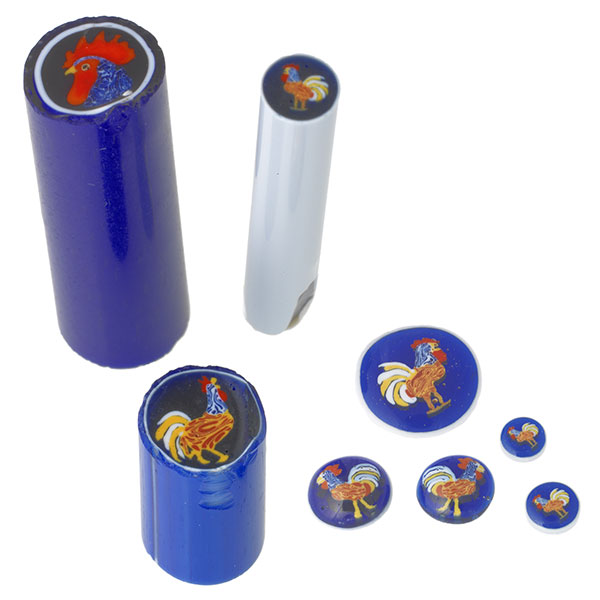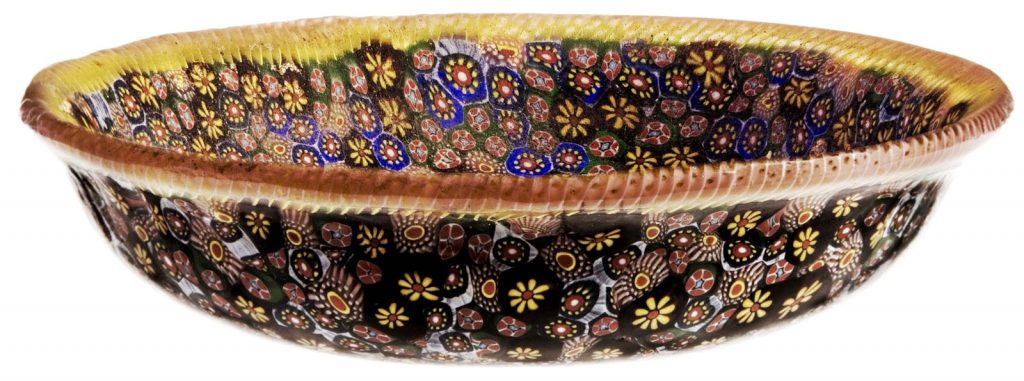If the origins of the artistic murrina can now be traced back to the year 1000 B.C., in the north-west of Iran (where for the first time a glass-maker produced a glass with five human figures and an animal), the technique of murrino glass was destined to soon disappear from the Egyptian, Greek and Roman furnaces, ousted by the more economical blown glass.
To find it on Murano, we have to wait until the second half of the XV century when Maria Barovier’s furnace gave birth to the rosetta bead, which was also used – by incorporating it when hot – to decorate small vases. Then there was another dormant period until 1830 when the craftsman Domenico Bussolin created the Millefiori rods and set them side by side with the traditional filigree ones.
Nevertheless, another decade was to pass before the bead-makers Giovanni Battista and Giacomo Franchini invented a series of creations and portraits so as to inaugurate the “trend” of the modern artistic murrina. Using the typical techniques of their trade, the Franchinis worked the rods with the help of the flame and small moulds, gradually adding rods to make increasingly more complex patterns. The figured murrine by the two bead-makers date from between 1843 and 1863.
However, the person who was to bring the production of the murrina back to the most typical of the Murano work places, that is to say the furnace, was Vincenzo Moretti (1835-1901). He was to hand down the tradition to his son Luigi (1867-1946) and – through the latter – to his grandson Ulderico (1892-1956) who was to become the father of Giusy Moretti.
The work of the Moretti family – as regards the artistic murrine – can be dated between 1873 and 1924.
Finally, we must mention the murrine made between 1915 and 1924 by another great master, Giuseppe Barovier (1853-1942). Therefore the artistic murrine which are part of the Giusy Moretti inheritance, are today considered genuine, unique collector’s items.

The artistic Murrina: The Moretti’s Technique (1873-1924)
So the “rediscoverer” and exponent of murrino glass (also known on Murano as “mosaic glass”) was Vincenzo Moretti whose work to retrieve Roman techniques did not begin with artistic murrine: bowls and vases, created by arranging numerous cross-sections of glass rods on a metal plate in order to form a predetermined pattern, were above all the subject of his initial research.
The metal plate was brought close to the furnaces where the various cross-sections, on melting, naturally fused together to form a sheet of glass bearing the pattern; said sheet, gathered up to be further worked with a blowpipe, acquired the desired form thanks to the ability of the master glass-blower.
Similar, but substantially different, is the procedure behind the murrina portraits: these are obtained by putting many thin, differently coloured glass rods side by side to form a cyclinder (called massello) 10 centimetres in diameter and 20 centimetres long. Thus the pattern ran all the way down the inside of the massello: on the front was the desired picture, on the back its mirror image, as in a slide.
The cylinder, tightly bound with a copper wire, was slowly heated at the furnace mouth and, when the glass reached the right fluidity, was pulled to become a long rod. The various cross-sections of this rod, cooled and cut into small rounds, are the artistic murrine – and therefore the portraits – just as they have been handed down to the present day.
Today much of the historical and experimental research carried out by Vincenzo Moretti forms the foundation of the present-day working of modern murrino glass: his “palette” of compatibility of glass and colours, whose purpose – when different vitreous components were put side by side – was to avoid breakages during the cooling process, is still one of the clearest examples of the boost he and his family gave to present-day glass-making on Murano.
